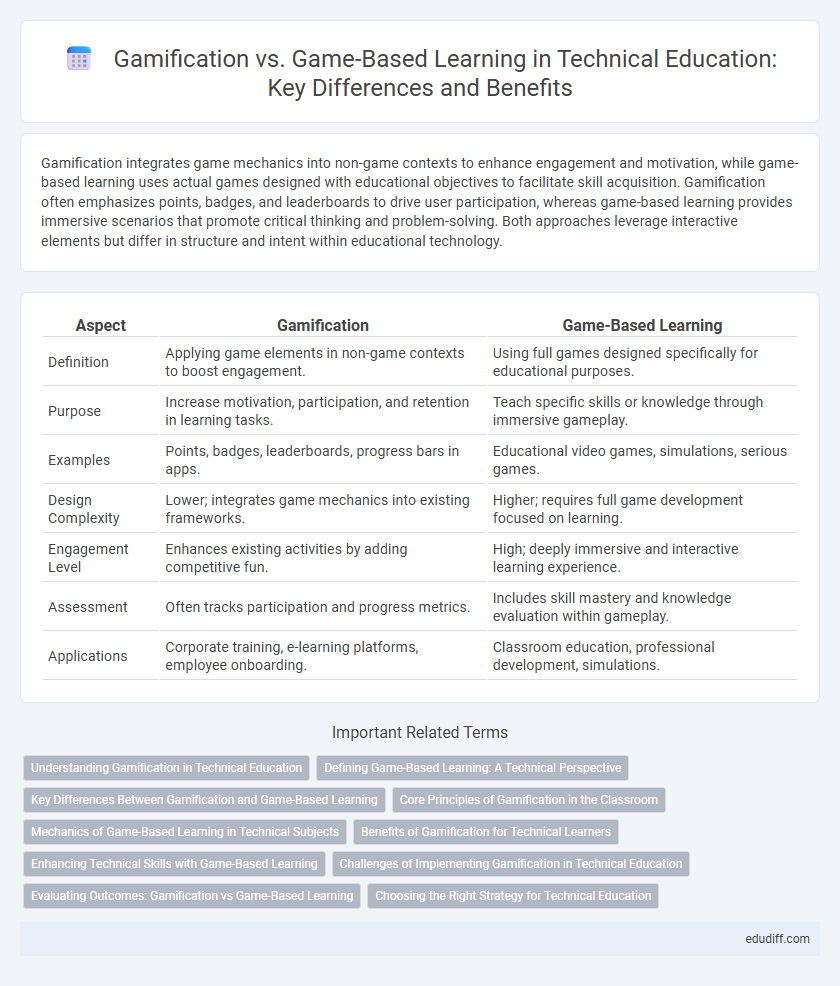Gamification integrates game mechanics into non-game contexts to enhance engagement and motivation, while game-based learning uses actual games designed with educational objectives to facilitate skill acquisition. Gamification often emphasizes points, badges, and leaderboards to drive user participation, whereas game-based learning provides immersive scenarios that promote critical thinking and problem-solving. Both approaches leverage interactive elements but differ in structure and intent within educational technology.
Table of Comparison
| Aspect | Gamification | Game-Based Learning |
|---|---|---|
| Definition | Applying game elements in non-game contexts to boost engagement. | Using full games designed specifically for educational purposes. |
| Purpose | Increase motivation, participation, and retention in learning tasks. | Teach specific skills or knowledge through immersive gameplay. |
| Examples | Points, badges, leaderboards, progress bars in apps. | Educational video games, simulations, serious games. |
| Design Complexity | Lower; integrates game mechanics into existing frameworks. | Higher; requires full game development focused on learning. |
| Engagement Level | Enhances existing activities by adding competitive fun. | High; deeply immersive and interactive learning experience. |
| Assessment | Often tracks participation and progress metrics. | Includes skill mastery and knowledge evaluation within gameplay. |
| Applications | Corporate training, e-learning platforms, employee onboarding. | Classroom education, professional development, simulations. |
Understanding Gamification in Technical Education
Gamification in technical education leverages game design elements such as points, badges, and leaderboards to enhance engagement and motivation without creating full-fledged games. This approach boosts problem-solving skills and knowledge retention by incorporating challenges and immediate feedback within existing curricula. Unlike game-based learning, which involves immersive simulations, gamification integrates seamlessly into technical training environments, driving learner participation and performance.
Defining Game-Based Learning: A Technical Perspective
Game-Based Learning (GBL) employs interactive digital games designed with specific educational objectives to enhance knowledge retention and skill acquisition through immersive experiences. Unlike general gamification, which integrates game mechanics into non-game contexts, GBL centers on complete game environments that simulate realistic scenarios for problem-solving and critical thinking. Technical implementation of GBL involves adaptive algorithms, real-time feedback systems, and data analytics to tailor learning paths and measure cognitive progress effectively.
Key Differences Between Gamification and Game-Based Learning
Gamification involves integrating game mechanics such as points, badges, and leaderboards into non-game contexts to increase engagement and motivation, whereas game-based learning uses actual games designed specifically for educational purposes to teach specific skills or knowledge. Gamification enhances traditional learning environments by adding elements of competition and reward, while game-based learning relies on immersive gameplay to promote active problem-solving and critical thinking. The key difference lies in gamification's focus on motivational frameworks applied broadly, contrasted with game-based learning's direct use of games as primary instructional tools.
Core Principles of Gamification in the Classroom
Core principles of gamification in the classroom include motivation, engagement, and feedback mechanisms designed to enhance learning outcomes through game-like elements such as points, badges, and leaderboards. These elements leverage intrinsic motivation by providing clear goals, immediate feedback, and progressive challenges that maintain student interest and promote active participation. Incorporating narrative and reward systems aligns with cognitive and behavioral theories to foster a dynamic learning environment without requiring full game simulation as seen in game-based learning.
Mechanics of Game-Based Learning in Technical Subjects
Game-Based Learning in technical subjects leverages core mechanics such as challenges, immediate feedback, and progressive difficulty to enhance problem-solving skills and practical application of concepts. These mechanics facilitate active engagement and reinforce knowledge retention by simulating real-world scenarios in fields like engineering, programming, and data analysis. Utilizing elements like scoring systems, badges, and leaderboards drives motivation and tracks learner progress effectively within a technical curriculum.
Benefits of Gamification for Technical Learners
Gamification enhances technical learning by increasing learner engagement through interactive elements such as points, badges, and leaderboards, which motivate continuous skill development. It facilitates real-time feedback and adaptive challenges, enabling learners to master complex technical concepts efficiently. By integrating game mechanics into training, technical learners experience improved knowledge retention and practical application of theoretical content.
Enhancing Technical Skills with Game-Based Learning
Game-based learning effectively enhances technical skills by providing interactive simulations and real-world problem-solving scenarios that promote experiential learning and critical thinking. Unlike gamification, which applies game elements to non-game contexts, game-based learning immerses learners in fully developed games designed to teach specific technical concepts and workflows. This immersive approach improves knowledge retention, skill application, and engagement in areas such as coding, engineering, and IT system management.
Challenges of Implementing Gamification in Technical Education
Implementing gamification in technical education faces challenges such as ensuring alignment between game mechanics and learning objectives to avoid superficial engagement. Technical subjects require complex problem-solving skills that may not easily translate into game formats, limiting effective knowledge transfer. Additionally, resource constraints and the need for specialized expertise often hinder the development of custom gamified content that meets curriculum standards.
Evaluating Outcomes: Gamification vs Game-Based Learning
Evaluating outcomes in gamification reveals enhanced learner engagement and motivation through point systems, badges, and leaderboards, driving behavioral change. In contrast, game-based learning demonstrates deeper conceptual understanding and skill acquisition by immersing learners in realistic simulations and problem-solving scenarios within the game environment. Metrics such as retention rates, performance improvement, and learner satisfaction are critical in distinguishing the effectiveness of gamification and game-based learning methodologies.
Choosing the Right Strategy for Technical Education
Gamification integrates game mechanics like points, badges, and leaderboards into technical education to boost engagement and motivation without altering the curriculum structure. Game-based learning uses fully developed games designed around educational content to provide immersive, interactive experiences that enhance problem-solving and critical thinking skills. Selecting the right strategy depends on learning objectives, available resources, and the complexity of technical skills being taught, with gamification suited for incremental motivation and game-based learning better for deep, conceptual understanding.
Gamification vs Game-Based Learning Infographic

 edudiff.com
edudiff.com